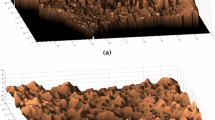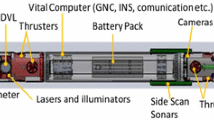Abstract
A recent concern in marine robotics is to consider the deployment of fleets of autonomous underwater vehicles (AUVs) and autonomous surface vehicles (ASVs). Multiple vehicles with heterogeneous capabilities have several advantages over a single vehicle system, and in particular the potential to accomplish tasks faster and better than a single vehicle. This paper addresses in this context the problem of underwater targets localization. A systematic and exhaustive coverage strategy is not efficient in terms of exploration time: it can be improved by making the AUVs share their information to cooperate, and optimize their motions according to the state of their knowledge on the target localization. We present techniques to build environment representations on the basis of which adaptive exploration strategies can be defined, and define an architecture that allows information sharing and cooperation between the AUVs. Simulations are carried out to evaluate the proposed architecture and the adaptive exploration strategies.
Similar content being viewed by others
References
Rahimi M, Pon R, Kaiser WJ, Sukhatme GS, Estrin D, Srivastava M (2004) Adaptive sampling for environmental robotics. In: IEEE international conference on robotics and automation, pp 3536–3544
Stentz A, Dias B, Zlot RM, Kalra N (2004) Market-based approaches for coordination of multi-robot teams at different granularities of interaction. In: Proceedings of the ANS 10th international conference on robotics and remote systems for hazardous environments
Meyer M, Hermand J-P (2006) Backpropagation techniques in ocean acoustic inversion: time reversal, retrogation and adjoint model—a review. Acoustic Sensing Techniques for the Shallow Water Environment
Zhang B, Sukhatme GS (2008) Adaptive sampling with multiple mobile robots. In: IEEE international conference on robotics and automation
Popa D, Sanderson A, Komerska R, Mupparapu S, Blidberg R, Chappel S (2004) Adaptive sampling algorithms for multiple autonomous underwater vehicles. Autonomous Underwater Vehicles IEEE/OES, pp 108–118
Alexandra M, Andreas K, Carlos G, Hellerstein JM (2007) Nonmyopic informative path planning in spatio-temporal models. In: AAAI’07: Proceedings of the 22nd national conference on Artificial intelligence. AAAI Press, Florida, pp 602–607
Low KH, Dolan J, Khosla P (September 2009) Information-theoretic approach to efficient adaptive path planning for mobile robotic environmental sensing. In: Proceedings of the 19th international conference on automated planning and scheduling (ICAPS-09)
Low KH, Dolan JM, Khosla P (2008) Adaptive multi-robot wide-area exploration and mapping. In: AAMAS ’08: Proceedings of the 7th international joint conference on Autonomous agents and multiagent systems, pp 23–30
Turner RM (2001) A two-level protocol-based approach to controlling autonomous oceanographic sampling networks. IEEE J Oceanic Eng 26: 654–666
Hallin JBN, Leidenfrost H, O’Rourke M, Edwards D (2009) Collaborative mapping with autonomous underwater vehicles in low-bandwidth conditions. In: Proceedings of Oceans’09 IEEE Bremen, Bremen, Germany
Parker LE (1998) Alliance: An architecture for fault tolerant multi-robot cooperation. IEEE Trans Robotics Autom 14: 220–240
Jiang D, Pang Y, Qin Z (2010) Application of moos-ivp architecture in multiple autonomous underwater vehicle cooperation. In: Control and decision conference (CCDC), pp 1802–1807
Herman M, Albus J (1988) Overview of the multiple autonomous underwater vehicles (mauv) project. In: IEEE international conference on robotics and automation, Philadelphia
McGann C, Py F, Rajan K, Thomas H, Henthorn R, McEwen R (2007) T-rex: a deliberative system for auv control. ICAPS
Akyildiz IF, Pompili D, Melodia T (2004) Challenges for efficient communication in underwater acoustic sensor networks. SIGBED Rev 1(2): 3–8
Allen J (1983) Maintaining knowledge about temporal intervals. Commun ACM 26: 832–843
Bernardini S, Smith D (2008) Translating pddl2.2. into a constraint-based variable/value language. In: ICAPS-08 Workshop on knowledge engineering for planning and scheduling (KEPS)
Frank J, Jónsson A (2003) Constraint-based attribute and interval planning. J Constraints, Special Issue Constraints Planning 8: 339–364
McGann C, Py F, Rajan K, Thomas H, Henthorn R, McEwen R (July 2008) Preliminary results for model-based adaptive control of an autonomous underwater vehicle. In: 11th Int’l Symp. on Experimental and Robotics (ISER)
Author information
Authors and Affiliations
Corresponding author
Rights and permissions
About this article
Cite this article
Belbachir, A., Ingrand, F. & Lacroix, S. A cooperative architecture for target localization using multiple AUVs. Intel Serv Robotics 5, 119–132 (2012). https://doi.org/10.1007/s11370-012-0107-1
Received:
Accepted:
Published:
Issue Date:
DOI: https://doi.org/10.1007/s11370-012-0107-1




